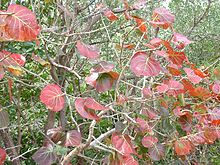- Coccoloba
-
Coccoloba 
Coccoloba uvifera (Seagrape) bush Scientific classification Kingdom: Plantae (unranked): Angiosperms (unranked): Eudicots (unranked): Core eudicots Order: Caryophyllales Family: Polygonaceae Genus: Coccoloba
P.BrowneSpecies See text
Coccoloba is a genus of about 120–150 species of flowering plants in the family Polygonaceae. The genus is native to tropical and subtropical regions of the Americas, in South America, the Caribbean and Central America, with two species extending into Florida.[1][2]
The species are shrubs and trees, mostly evergreen. The leaves are alternate, often large (to very large in some species), with the leaves on juvenile plants often larger and of different shape to those of mature plants. The flowers are produced in spikes. The fruit is a three-angled achene, surrounded by an often brightly coloured fleshy perianth, edible in some species, though often astringent.[1][2]
There is no overall English name for the genus, although many of the individual species have widely used common names.
Contents
Selected species
- Coccoloba acuminata
- Coccoloba caracasana Papaturro
- Coccoloba costata Uvilla
- Coccoloba diversifolia Pigeonplum
- Coccoloba krugii Whitewood Seagrape
- Coccoloba microstachya Puckhout
- Coccoloba pallida Pale Seagrape
- Coccoloba pubescens Grandleaf Seagrape
- Coccoloba pyrifolia Uvera
- Coccoloba rugosa Ortegon
- Coccoloba sintenisii Uvero de Monte
- Coccoloba swartzii Swartz's Pigeonplum
- Coccoloba tenuifolia Bahama Pigeonplum
- Coccoloba uvifera Seagrape
- Coccoloba venosa False Chiggergrape
Ecology
The genus includes several ectomycorrhizal species; for example, C. uvifera is apparently associated with at least the following macrofungal families Amanitaceae, Russulaceae, and Boletaceae. The species Coccoloba cereifera is notable for being restricted to an area of only some 26 square km on a single low peak near Serra do Cipó National Park, in the Brazilian state of Minas Gerais.[1]
Cultivation and uses
One species, Coccoloba uvifera (Seagrape) is commonly cultivated for its edible fruit, and the genus name is sometimes used to denote this species.
References
- ^ a b Flora of North America: Coccoloba
- ^ a b Huxley, A., ed. (1992). New RHS Dictionary of Gardening. Macmillan ISBN 0-333-47494-5.
- ^ USDA Plants Profile: Coccoloba
- ^ Global Compendium of Weeds: Coccoloba acuminata
- ^ Plants of Hawaii: Polygonaceae

This Polygonaceae article is a stub. You can help Wikipedia by expanding it.
